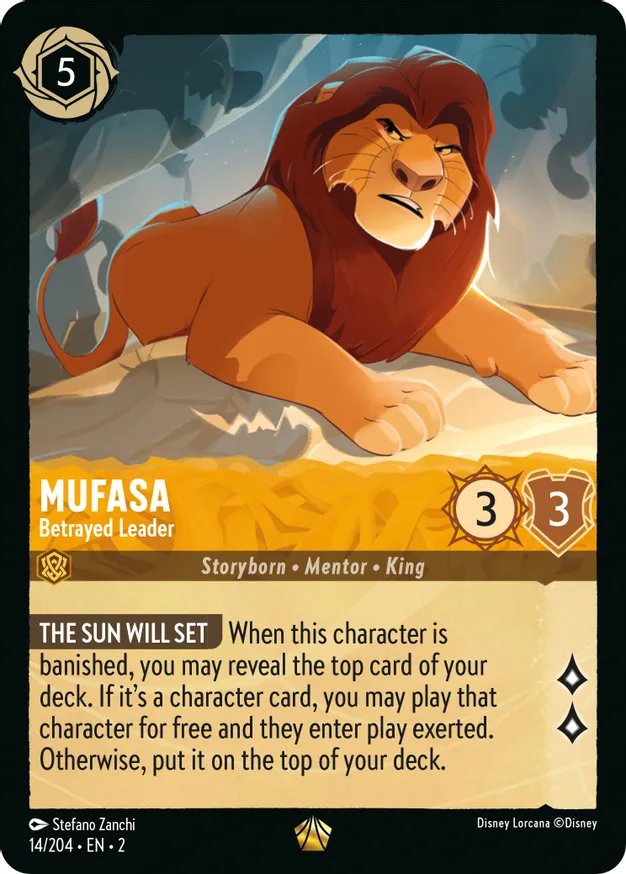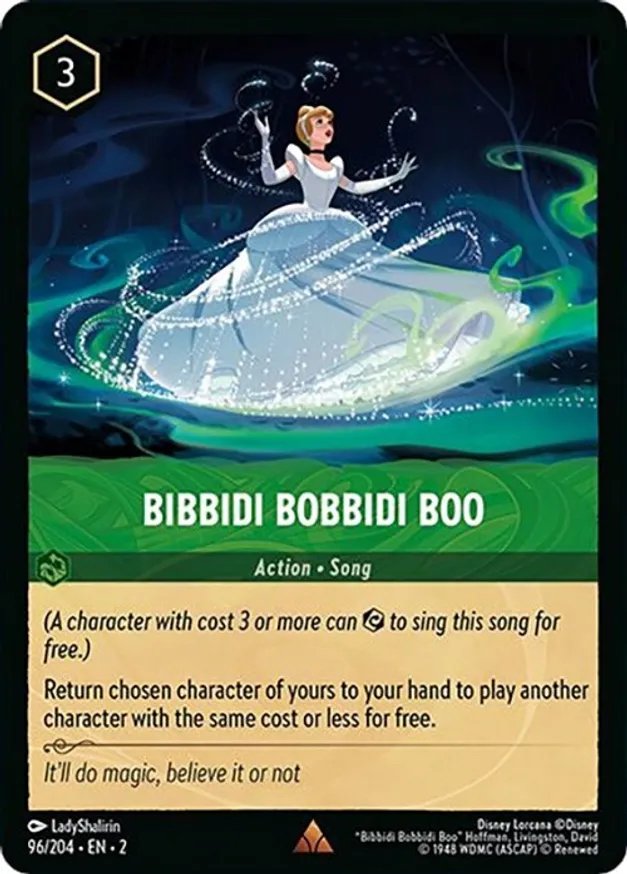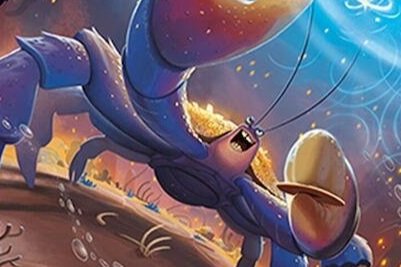Greenfasa (Mufasa/Emerald) Deck List and Guide
Mufasa was largely overlooked when Rise of the Floodborn first was released. However, it didn’t take long for players to realize just how much potential this powerful card had. In this deck list and guide, we’re going to be looking at a tournament topping deck that Alex Hansen used featuring Mufasa and built on the powerful Emerald/Amber pairing that has long been a staple in the Lorcana meta.
Mufasa/Emerald Deck List
-
3 Rapunzel - Gifted with Healing
3 Hades - Lord of the Underworld
4 Ray - Easygoing Firefly
3 Stitch - Carefree Surfer
4 Simba - Protective Cub
4 Genie - On the Job
4 Stitch - Rock Star
4 Stitch - New Dog
4 The Queen - Commanding Presence
4 Mufasa - Betrayed Leader
4 Doc - Leader of the Seven Dwarfs
4 The Queen - Regal Monarch
4 Tinker Bell - Most Helpful
4 Pain - Underworld Imp
3 Bibbidi Bobbidi Boo
4 Panic - Underworld Imp
Mufasa/Emerald deck strategy guide
If you are already familiar with the popular Mufasa Roulette deck, then learning how this deck works shouldn’t be too much trouble. The basic mechanics are largely the same. However, this deck is a little tighter with fewer characters, making it likely to be even more consistent than that other deck which relies largely on luck (hence the name).
Low cost characters shift into stronger ones
The Shift mechanic is a powerful one and very popular in Lorcana. If you aren’t familiar with how it works, it basically lets you replace an existing character in play with a new and stronger character. The real competitive advantage here is, however, that the newly shifted character ignores the “wait one turn” rule that Lorcana has, saying that the character has already dried (assuming it has been in play).
The two characters that you’ll be able to shift in this deck are Stitch and The Queen.
Stitch – New Dog
The Queen – Regal Monarch
Both shift into very strong characters: Rockstar Stitch and Commanding Presence Queen. However, if you have to choose which one of these characters to priorize early game, the answer is pretty easy. Go with the Queen. The Queen Commanding presence is much easier to play thanks to her incredibly low two-cost shift.
The Queen – Commanding Presence
Additional turn two options
Getting five-cost Queen out on turn two is a pretty powerful move. However, it certainly won’t happen all the time. Luckily, you have plenty of other turn two options to choose from. For starters, this deck runs the incredibly versatile Simba – Protective Cub. Simba is almost mandatory for Amber decks given just how strong he is.
Simba – Protective Cub
What really makes Simba so good is that he has bodyguard and he’s only a cost two character. This means you can quickly begin defending your strategically important characters from getting picked off too early by having him in play. Having a will power of three doesn’t hurt either, making him relatively tough to take out.
Apart from Simba, this deck also runs the dynamic Pain/Panic combo to help you start gaining lore quickly. Turn two is ideal for getting this combo going, as you will be able to play Pain starting turn two (assuming you get ink into your inkwell each turn).
Pain – Underworld Imp
What makes this Pain card so good is that he pairs really well with Panic or even The Queen. Simply use Panic’s ability or The Queen’s ‘Who is the Fairest’ to instantly increase Pain’s strength to five, enabling him to quest for an impressive three lore.
Use Doc to supercharge this character-driven deck
Doc – Leader of the Seven Dwarfs
Of course, not all decks use the same strategy. And while Doc can be a strong addition to many decks, he becomes quite vital in decks that focus exclusively or almost exclusively on character cards. Decks like this one.
Deck is probably your most strategic card to play on turn three. Having him in play means you can gain two lore when he quests but also benefit from paying less for the next character you play that turn. This makes it continually easier to play whatever character card you want throughout the game, and also means that the next turn you can play this deck’s star: Mufasa.
Play Mufasa and tap into this deck’s greatest strength
Mufasa – Betrayed Leader
If you have Doc in play, you can play Mufasa as early as turn four. I highly recommend that you do, as Mufasa really is the backbone of this deck. There are a few reasons why Mufasa is so strong – strong enough to build a deck around.
Stats are solid (good attacker, solid quester)
An ability that undermines the current Lorcana meta
By enabling you to play any charcter card for free, you greatly diminish your opponent’s chances of wiping the board clean and preventing you from continuing to gain lore.
Mufasa is an especially strong character card in a meta that is dominated by decks that play the ultimate Be Prepared song – instantly banishing all of your hard work and players from the field.
Guess what, though? With Mufasa on the field, you will only replace your banished characters with newer and possibly stronger characters.
Leverage powerful abilities with Bibbidi Bobbidi Boo
Bibbidi Bobbidi Boo
The last strategy we’re going to talk about revolves around Bibbidi Bobbidi Boo. Using this powerful song card, you can take advantage of the many abilities the characters in this deck have that activate from the hand. Additionally, it allows you to capitalize on the fact that you get to play characters for free with Mufasa. If you play a particular card for free from the top of your deck but you’d prefer to have another character from your hand, simply sing this song and you can play that character.
This works particularly well with cards like Genie – On The Job, which can be bounced back into your hand for another Genie, thereby using his ability twice.
Genie – On the Job
And while I love the inclusion of the often overlooked Genie, he’s far from the only use case for this strong song. This deck runs multiple cost four characters which benefit you from being played from the hand (Rapunzel’s ‘Gifted with Healing ability’ and Hades’s ‘Well of Souls’ for example) which are also ideal targets to be used in tandem with Bibbidi, while you can even use it to bounce and play low cost characters in tandem with Rockstar Stitch to draw extra cards.
Mufasa/Emerald deck is a strong alternate Mufasa deck
While Amber/Ruby may be the preferred Mufasa deck, many players will still prefer this ink combo over that one, either because they like Emerald better or because they prefer something with a little more consistency and synergy.
While this deck certainly lacks many of the high powered card that Amber/Ruby leverages, Mufasa/Emerald has a more cohesive strategy and less randomness to it, making it less luck-based and more appealing to players less comfortable with the roulette nature of Mufasa.
The inclusion of Bibbidi incorporates some fun gameplay mechanics as well, and of course the deck itself has proven success on the competitive scene, meaning it is no slouch for competitive players as well as more casual ones looking to try something new.




















